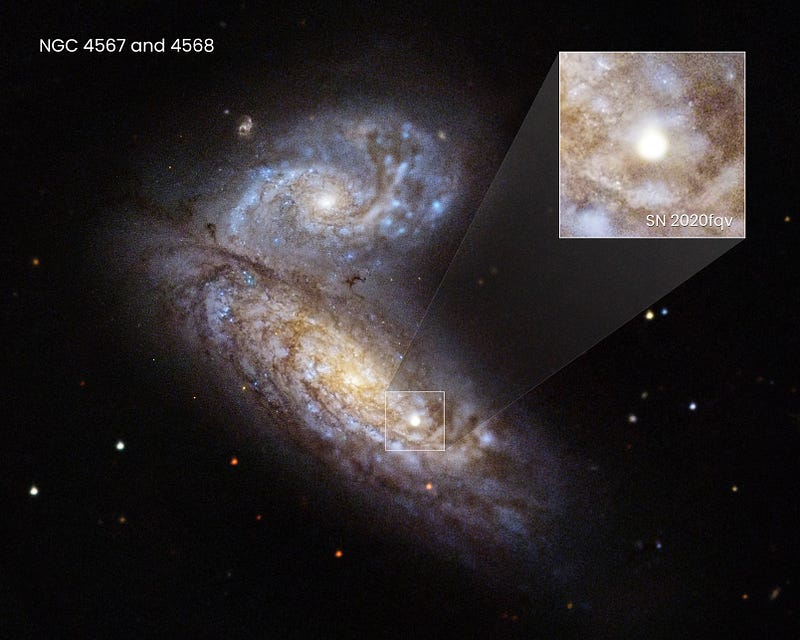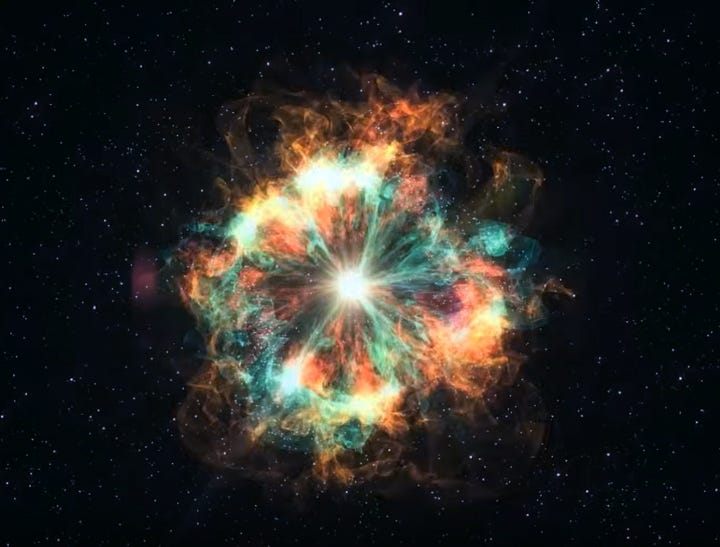Spectacular Supernova: A Unique Snapshot of Cosmic Explosion
Written on
Chapter 1: A Historic Discovery
Recently, NASA unveiled an extraordinary image showcasing a supernova explosion, capturing the precise moment of the event. This remarkable photo marks the first time astronomers have witnessed a star exploding so early in its life cycle.

[Photo: NASA, ESA, Ryan Foley (UC Santa Cruz) IMAGE PROCESSING: Joseph DePasquale (STScI), Public domain, via Wikimedia Commons]
This rare occurrence, designated SN 2020 fqv, was initially detected by a team of astronomers led by Ryan Foley from the University of California, Santa Cruz, at the Palomar Observatory in California. They quickly recognized that other observatories, including the TESS space telescope, had also recorded the supernova. TESS, primarily designed for exoplanet searches, captured this moment as well. Consequently, a prompt message was sent to the Hubble Space Telescope to focus on the explosion's location, which yielded successful results. This image showcases the supernova at the very moment it detonated. Historically, supernovae have only been photographed days, weeks, or even months after their explosions. This unprecedented view is truly exceptional.
Section 1.1: Understanding Supernovae
The explosion was identified in April 2020 within the galaxy NGC 4568, located in the Virgo constellation, approximately 60 million light-years away. This galaxy is closely associated with another, NGC 4567, leading to their nickname, the “Siamese Twins.” Together, they appear as a single entity from Earth, resembling a vast cosmic butterfly, though they are actually two distinct and powerful spiral galaxies.
Supernovae are fascinating celestial events, marking the explosive end of massive stars. While they are often referred to as stars, they are, in reality, the spectacular explosions of stars that have reached the end of their life cycles. These events are not permanent cosmic entities but rather brief yet intensely energetic phenomena that outshine even the brightest regions of massive galaxies. Despite their brilliance, supernovae vanish from sight relatively quickly, typically within weeks to months, often leaving behind neutron stars or black holes.

Neutron star simulation — [Photo: Raphael.concorde, CC BY-SA 4.0, via Wikimedia Commons]
Supernovae can be classified into several categories; however, let's focus on the two most common types. The first is known as Ia supernovae. This type occurs in a binary star system where a white dwarf, the remnant of a star that has exhausted its nuclear fuel, interacts with a normal companion star. Despite its small size—comparable to Earth—the white dwarf possesses a mass similar to that of the Sun. For millions of years, both stars orbit a common center of gravity, during which the white dwarf siphons material from its companion. Once it accumulates enough mass (known as the Chandrasekhar limit), a catastrophic thermonuclear explosion occurs, resulting in a Ia supernova.
Subsection 1.1.1: The Life Cycle of Stars
The second type, known as supernovae II, typically involves solitary massive stars ranging from 9 to 20 solar masses. Once these stars exhaust their hydrogen supply, the internal pressure decreases, leading gravity to take over. When the core reaches a mass exceeding 1.4 solar masses, it collapses, triggering a reaction that converts protons and electrons into neutrons. The outer layers then collapse inward, resulting in a violent explosion. In both Ia and II supernovae, a significant portion of the star’s material is expelled into space. The SN 2020 fqv explosion involved a star with a mass between 10 and 15 solar masses.

Supernova — [Photo: License, as on date of upload: ‘Creative Commons Attribution license (reuse allowed)’ , CC BY 3.0, via Wikimedia Commons]
Additionally, there are supernovae associated with the demise of extremely massive stars, those with masses in the tens or even hundreds of solar masses. These events are more complex but play a crucial role in the universe. Supernovae serve as significant sources for the production of elements heavier than oxygen. Elements heavier than iron are predominantly formed in these explosions and in kilonovae—events resulting from neutron star collisions. These heavy elements eventually contribute to the formation of nebulae, the stellar nurseries where new stars and planets emerge, enriching them with the building blocks necessary for life.
Chapter 2: Observing Cosmic Events in Real Time
Thanks to the rapid response of astronomers and images from Hubble, we can now observe a supernova explosion in unprecedented detail, witnessing the phenomenon from its very inception. Ryan Foley remarked on this groundbreaking observation:
“Until now, supernova observation has been akin to investigators arriving at a crime scene after the fact, who then had to meticulously reconstruct the circumstances of the event, step by step. This observation is something completely different — investigators arrive at the scene of the crime and can observe everything in real time.”
The SN 2020 fqv event occurred two years ago, but it wasn't until October 2021 that its findings and Hubble images were made public.
The first video titled "SUPERNOVA seen NAKED EYE (and YOU missed it)" explores the significance of this rare observation and what it reveals about the universe.
The second video, "What Could Produce an Explosion 100x of Supernova Power?" delves into the possibilities of cosmic phenomena far beyond our current understanding.
What is time for us?
For everyone, time flows at a different pace. For some, it seems to stretch endlessly, while for others, it slips away almost too quickly…
Did you enjoy the article? If so, please leave a comment or some applause. Your support motivates me to continue creating engaging content. Feel free to follow me for daily updates — thank you!